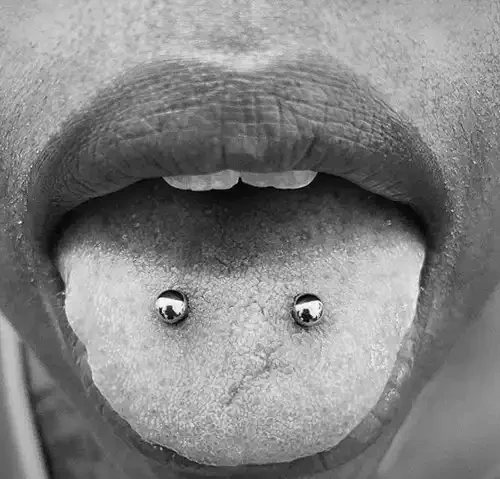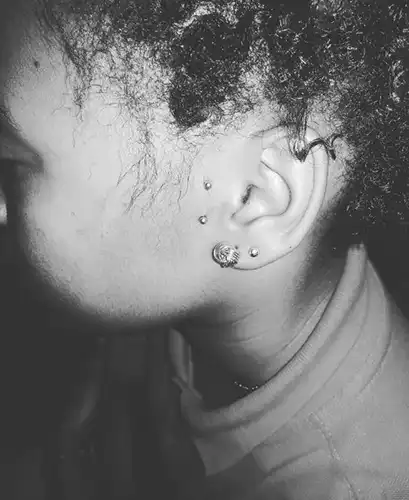Surface Piercings in Nairobi, Kenya
Surface piercings are a type of body modification where jewelry is inserted under the skin’s surface, rather than going through a distinct entry and exit point like traditional piercings. These piercings are typically placed on flat areas of the body, such as the nape of the neck, the wrists, or the chest. They require careful placement and skilled technique because they don’t have the natural support of cartilage or firm tissue like earlobes or nostrils.
Surface Piercing
Types of Surface Piercings
Surface piercings come in various types, each suited to different parts of the body for a unique and stylish look. Here are some popular types:
- Nape Piercing: Located on the back of the neck, this piercing runs horizontally across the nape. It’s a bold choice and often hidden by hair, making it a subtle yet edgy option.
- Hip Piercing: These are placed on either side of the hips, usually at the front or along the hip bone. Often done in pairs, hip piercings are popular for their symmetry and are commonly chosen by those who want a body-modification style statement.
- Chest/Cleavage Piercing: This piercing is located in the chest area, usually between the breasts, making it a popular choice for its visually striking appearance. It can be vertical or horizontal, depending on personal preference and the anatomy of the area.
- Anti-Eyebrow Piercing (Upper Cheek): Placed on the upper cheekbone, typically just below the eye. Also known as a teardrop piercing, it’s positioned diagonally or horizontally and provides a bold look around the eye area.
- Wrist Piercing: Placed on the wrist, this piercing is unconventional and eye-catching. Due to the constant movement of the wrists, it can be challenging to heal and may be more prone to rejection.
- Belly button piercing: located around or through a part of the navel
- Bridge piercing: located horizontally at the bridge of the nose.
- Eyebrow piercing: this goes through the eyebrow or through the skin around the eyebrow.
- Tragus surface piercings vertically pierce the skin next to the tragus.
Surface piercings can add a unique, artistic touch to the body, though they may have a higher risk of rejection. Choosing the right placement and practicing strict aftercare are essential to help these piercings heal successfully.
Surface Piercings Procedure
The surface piercing procedure is a bit more complex than a standard piercing since it involves placing jewelry horizontally under the skin on flat areas of the body. Here’s what to expect:
- Consultation: Before the procedure, you’ll typically have a consultation with one of our piercers. During this discussion, you can talk about your desired piercing location, the type of jewelry you prefer, and any concerns or questions you may have. Our piercer will assess whether the chosen location is suitable for a surface piercing and discuss the risks involved.
- Preparation: Once you’ve decided on the piercing, our piercer will prepare the area by cleaning it thoroughly with an antiseptic solution. They may mark the entry and exit points with a surgical pen to ensure precise placement.
- Piercing: Using a sterilized needle or piercing tool, our piercer will create a channel under the skin’s surface for the jewelry. This step requires careful technique to avoid damaging underlying tissues and blood vessels. The jewelry is then inserted into the channel, with both ends positioned just beneath the skin’s surface.
- Jewelry Selection: Surface piercings require special jewelry designed to minimize the risk of irritation and promote healing. Typically, flat or curved barbells made of biocompatible materials like titanium or implant-grade stainless steel are used. Our piercer will select jewelry that fits the piercing and minimizes the likelihood of rejection or migration.
- Aftercare Instructions: After the piercing is complete, our piercer will provide you with detailed aftercare instructions. This typically involves cleaning the piercing with saline solution or a mild soap, avoiding trauma or excessive movement, and refraining from changing the jewelry until the piercing is fully healed.
- Follow-Up: When you get your piercing done at Rebel Inks Tattoos, Tattoo Removal, and Body Piercings Parlour, it’s essential to schedule follow-up appointments with our piercer to monitor the healing progress and address any concerns. Surface piercings can be prone to complications like migration or rejection, so regular check-ups are crucial for early detection and intervention if needed.
Surface piercings can take longer to heal than standard piercings due to their position on flat areas of the body, but with proper aftercare, they can heal successfully.
Surface Piercing FAQ’s
Considerations before getting a Surface Piercing
Before getting a surface piercing, it’s important to consider several factors to ensure you make an informed decision and minimize risks:
- Placement: Surface piercings can be done on various parts of the body, but not all areas are suitable. Flat surfaces with enough skin to accommodate the jewelry are ideal. Consider the anatomy of the chosen area and discuss placement options with a skilled piercer to ensure the best outcome.
- Healing Time: Surface piercings typically take longer to heal compared to traditional piercings due to their placement under the skin’s surface. Healing times can vary depending on factors such as location, individual healing abilities, and aftercare practices. Be prepared for a healing period of several months to a year or more.
- Risk of Migration and Rejection: Surface piercings are more prone to migration (shifting of the jewelry within the skin) and rejection (the body pushing out the jewelry) compared to piercings through firmer tissue like cartilage. Understand the risks involved and be vigilant for signs of migration or rejection during the healing process.
- Aftercare Commitment: Proper aftercare is crucial for the healing and success of a surface piercing. This typically involves cleaning the piercing with saline solution or a mild soap, avoiding trauma or excessive movement, and following any specific instructions provided by your piercer. Consider whether you’re willing and able to commit to the necessary aftercare routine.
- Lifestyle Factors: Consider how a surface piercing may impact your daily activities and lifestyle. Certain activities or clothing choices may need to be adjusted during the healing process to avoid irritation or damage to the piercing. Additionally, think about whether your job or hobbies pose any risks to the piercing’s health.
- Pain Tolerance: Surface piercings can be more painful than traditional piercings due to their placement and the technique involved. While pain levels vary from person to person, be prepared for some discomfort during the piercing process and throughout the healing period.
- Jewelry Options: Surface piercings require specialized jewelry designed to minimize irritation and promote healing. Consider the type of jewelry you prefer, such as flat or curved barbells made of biocompatible materials like titanium or implant-grade stainless steel.
- Consultation with a Piercer: Before proceeding with a surface piercing, schedule a consultation with one of our reputable and experienced piercers. They can assess your anatomy, discuss placement options, explain the procedure and aftercare requirements, and address any concerns or questions you may have.
By carefully considering these factors and seeking guidance from a knowledgeable piercer, you can make an informed decision about whether a surface piercing is right for you and take steps to ensure a safe and successful outcome.
Surface Piercing Pain and Healing
Surface piercings typically involve more discomfort during the piercing process and can have a longer healing time compared to standard piercings. Here’s what you can expect regarding pain and healing:
Surface piercings involve passing the needle or piercing tool through multiple layers of skin, which can be more painful compared to piercings through cartilage or softer tissue. The level of pain experienced varies from person to person depending on individual pain tolerance, the location of the piercing, and the skill of the piercer.
If you get a nape piercing or a piercing closer to your eye, it will probably hurt more than a surface piercing on your chest or near your collarbone. It will definitely hurt far more if you receive a surface piercing in or close to your genital area.
Often, to complete your surface piercing, our piercer will simply pinch the skin that you want to be pierced and stick the needle straight through. With this process, the surface piercing shouldn’t hurt more than other piercing types in fleshy areas.
Otherwise, our piercer may decide to use a scalpel rather than a needle to insert the surface piercing, depending on where it will be placed. This method often allows them to pierce deeply enough to lower the risk of rejection, but it could be more painful than using a needle.
After the piercing is done, you may experience soreness, tenderness, and swelling in the pierced area. This discomfort is a normal part of the healing process and typically subsides within a few days to a week.
Surface piercings have a longer healing time compared to traditional piercings due to their placement under the skin’s surface. While individual healing times can vary, surface piercings often take several months to a year or more to fully heal. During this time, it’s essential to follow proper aftercare practices to promote healing and reduce the risk of complications.
Proper aftercare is crucial for the healing and success of a surface piercing. This typically involves cleaning the piercing with saline solution or a mild soap, avoiding trauma or excessive movement, and following any specific instructions provided by your piercer. Be consistent with your aftercare routine to minimize the risk of infection, migration, or rejection.
Surface piercings are more prone to complications such as migration (shifting of the jewelry within the skin) and rejection (the body pushing out the jewelry) due to their placement and the body’s natural movements. It’s important to monitor the piercing regularly for signs of these complications, such as changes in appearance, increased pain or swelling, or the jewelry becoming more visible under the skin.
If you experience any concerns or complications during the healing process, don’t hesitate to reach out to our piercer for guidance. They can assess the piercing, provide advice on proper care, and recommend any necessary steps to address issues and promote healing.
Surface Piercing Aftercare
Proper aftercare is crucial for the healing and success of a surface piercing. Here’s a general aftercare routine to follow:
- Clean the Piercing: Gently clean the piercing twice a day using a saline solution or a mild, fragrance-free soap. Soak a clean cotton ball or pad in the solution and gently wipe around the piercing to remove any crusted discharge or debris. Avoid rotating or moving the jewelry excessively during cleaning, as this can irritate the piercing.
- Rinse Thoroughly: After cleaning the piercing, rinse it thoroughly with water to remove any remaining soap or saline solution. Make sure there are no soap residues left on the jewelry or the surrounding skin, as they can cause irritation.
- Pat Dry: Gently pat the piercing and surrounding area dry with a clean, disposable paper towel or a soft, lint-free cloth. Avoid using towels or fabrics that may harbor bacteria or lint, as these can increase the risk of infection.
- Avoid Harsh Products: Avoid using harsh or alcohol-based cleansers, hydrogen peroxide, or ointments on the piercing, as they can dry out the skin and delay healing. Stick to saline solution or mild soap recommended by your piercer.
- Avoid Touching: Resist the temptation to touch or play with the piercing, as this can introduce bacteria and increase the risk of infection. Only handle the piercing when necessary for cleaning, and always wash your hands thoroughly before touching it.
- Avoid Trauma: Avoid activities that may put pressure or strain on the piercing, such as sleeping on it or wearing tight clothing that rubs against it. Be mindful of accidental bumps or knocks, especially during the healing period.
- Monitor for Signs of Infection: Keep an eye on the piercing for any signs of infection, such as increased redness, swelling, pain, warmth, or discharge that is thick, green, or foul-smelling. If you notice any signs of infection or other complications, contact your piercer or a healthcare professional for advice.
- Follow-Up Appointments: Schedule follow-up appointments with our piercer as recommended to monitor the healing progress and address any concerns or complications. Our piercer can provide guidance on when it’s safe to change the jewelry and answer any questions you may have about caring for your piercing.
By following these aftercare guidelines and staying vigilant for any signs of trouble, you can promote healing and reduce the risk of complications with your surface piercing. Remember that everyone’s healing process is unique, so don’t hesitate to reach out to our piercer if you have any concerns or questions along the way.
Surface Piercing Jewelry
Choosing the right jewelry for a surface piercing is essential for both aesthetic appeal and proper healing. Here are some considerations when selecting surface piercing jewelry:
- Material: Opt for high-quality, biocompatible materials that are safe for initial and long-term wear. Titanium, implant-grade stainless steel, and niobium are popular choices because they are hypoallergenic and less likely to cause irritation or allergic reactions. Avoid materials like nickel, which can trigger allergies and may hinder healing.
- Design: Surface piercing jewelry comes in various designs to accommodate different piercing locations and preferences. Common options include flat or curved barbells, surface bars, and anchored studs. The design should be suitable for the specific anatomy of your piercing site and minimize the risk of irritation or migration.
- Size and Length: Choose jewelry that fits your piercing comfortably without being too tight or too loose. Surface piercings require longer jewelry to accommodate the depth of the piercing and allow for swelling during the healing process. The length of the jewelry should be carefully measured by your piercer to ensure proper fit and prevent complications.
- Flat Ends: Jewelry ends should be flat to sit flush against the skin’s surface and minimize friction or irritation. Flat ends reduce the likelihood of catching on clothing or bedding, which can disrupt healing and increase the risk of complications.
- Threadless or Threaded: Surface piercing jewelry is available in both threadless and threaded designs. Threadless jewelry features a push-fit mechanism that makes it easy to insert and remove without twisting, while threaded jewelry requires screwing the ends onto the post. Choose the type of jewelry that you find most comfortable and convenient to wear.
- Gemstones and Decorations: If you prefer embellished jewelry, opt for gemstones or decorative elements that are securely set and won’t snag on clothing or bedding. Smooth, bezel-set gemstones are less likely to catch on fabric compared to prong-set or claw-set stones.
- Consult with Your Piercer: Our piercer is your best resource for selecting the right jewelry for your surface piercing. They will assess your anatomy, discuss your preferences, and recommend suitable options based on their expertise and experience. Don’t hesitate to ask questions or seek guidance to ensure you choose jewelry that promotes healing and complements your style.
Styles of Surface Piercing Jewelry
The location of the piercing and your body have a significant impact on the jewelry designs for surface piercings.
Barbells that are designed specifically for surface piercings in flatter areas are known as surface barbells or staple barbells. Although the name suggests that this particular jewelry is intended especially for all surface piercings, some areas should actually wear a curved or straight barbell. Your piercer will let you know which jewelry type you should use.
Curved barbells are also effective in many surface-piercing spots. The barbell’s curve provides a similar role to the surface barbell’s staple shape. Be cautious when using this kind because the curve may force the beads up against the piercing holes in flatter locations.
Certain surface piercings can use straight barbells. Ask your piercer before picking a straight barbell for your piercing because it should never be used in many types of surface piercings.
You can choose opal, pearl, or diamond ball types, have some fun with charms, or use surface barbells, circular barbells, or straight barbells depending on the preference of your piercing.
Cost of a Surface Piercing in Nairobi, Kenya
The cost of a surface piercing can vary depending on several factors, including the location of the piercing, the expertise of the piercer, the jewelry chosen, and the geographic location of the piercing studio. Here’s a breakdown of potential costs associated with getting a surface piercing:
- Piercing Fee: This is the base fee charged by our piercing studio for the service of performing the piercing. The cost may vary based on the complexity of the piercing. Surface piercings often require more skill and precision than standard piercings, which can influence the price.
- Jewelry Cost: The price of the jewelry used for the surface piercing can vary depending on the material, design, and brand. Higher-quality materials like titanium or gold may cost more than stainless steel, and intricate or custom-designed jewelry may come with a higher price tag. Surface piercings typically require specialized jewelry designed to accommodate the unique anatomy and movement of the piercing, which can affect the overall cost.
- Additional Services: At Rebel Inks Tattoos, Tattoo Removal, and Body Piercings Parlour our piercers may offer additional services or perks as part of the piercing package, such as consultation fees, aftercare products, or follow-up appointments. These services can impact the overall cost of the piercing experience.
It’s important to research piercing studios in your area, read reviews, and inquire about pricing before scheduling an appointment. While cost is a factor to consider, prioritize finding a reputable piercer with experience in surface piercings and a commitment to safety and hygiene. Investing in a skilled professional and high-quality jewelry can contribute to a successful and satisfying piercing experience.
Possible side effects of Surface Piercing
Surface piercings, like any body modification procedure, come with potential risks and side effects. Here are some possible side effects and complications associated with surface piercings:
- Infection: One of the most common risks associated with any piercing is infection. Bacteria can enter the piercing site during the procedure or through improper aftercare practices, leading to redness, swelling, pain, and discharge. Prompt treatment with antibiotics may be necessary to resolve the infection.
- Migration: Surface piercings are more prone to migration than piercings through firmer tissue like cartilage. Migration occurs when the body attempts to push the jewelry out of the skin, resulting in the piercing shifting position over time. This can lead to changes in the piercing’s appearance and may necessitate removal of the jewelry.
- Rejection: Rejection is a more severe form of migration where the body completely pushes the jewelry out of the skin. This often occurs due to the body’s immune response to the foreign object, leading to the formation of scar tissue around the piercing site. Rejection can result in scarring and the loss of the piercing.
- Keloids and Hypertrophic Scarring: Some individuals are prone to developing keloids or hypertrophic scars, which are raised, thickened scars that form at the piercing site. These scars can be itchy, uncomfortable, and may require additional treatment to manage.
- Embedding: In rare cases, surface piercings may become embedded in the skin if the jewelry is too small or if excessive pressure is applied to the piercing site. Embedded jewelry can cause pain, irritation, and tissue damage and may require professional removal.
- Nerve Damage: Improper placement or technique during the piercing procedure can result in nerve damage, leading to numbness, tingling, or loss of sensation in the surrounding area. This can be temporary or permanent depending on the extent of the damage.
- Allergic Reactions: Some individuals may experience allergic reactions to the metals or materials used in surface piercing jewelry. Symptoms may include redness, itching, and swelling at the piercing site. Choosing high-quality, hypoallergenic materials can help minimize this risk.
- Delayed Healing: Surface piercings typically have longer healing times compared to traditional piercings due to their placement under the skin’s surface. Factors such as poor aftercare, trauma, or underlying health conditions can delay healing and increase the risk of complications.
It’s essential to be aware of these potential side effects and take steps to minimize risks by choosing a reputable piercer, following proper aftercare guidelines, and monitoring the piercing closely for any signs of trouble. If you experience any concerning symptoms or complications, seek prompt medical attention for appropriate treatment.
Get In Touch
For more information on the list above and any other special services,please call or come in for free consultation
Testimonials
After he pierced my industrial piercing and seeing his amazing work, I feel even more excited about getting my tattoo with him in January. I’m really looking forward to it!
I am extremely happy with my new 'Safari' tattoo from Eric at Rebel Inks! The quality of the artwork is fantastic. Eric is a true professional and an amazing artist.
The preparation and design process was thorough and collaborative. He was very patient with my specific requests, including making sure all the elements, which hold personal meaning, were perfect.
The service was friendly and highly professional from start to finish. Despite the 8-hour session, Eric was a pleasant person to spend the time with.
The aftercare guidance and follow-up have been excellent and careful, which has made the healing process easy and better than expected.
I highly recommend Eric for anyone looking for a thoughtful, talented, and caring tattoo artist.
I recommend them 💯
I would definitely recommend if you’re thinking of getting a piercing!
The staff were super friendly, explained everything clearly, and made me feel so at ease. They answered all my nervous questions (and I had many questions),
They walked me through the whole process, gave detailed aftercare instructions, and even followed up afterward to check how I was healing 🫶
Clean, professional, and full of good vibes.
Would 100% recommend . Definitely making a second trip here.
This was the second tattoo I got and I wish I could have come to Eric for my first one! He gave me really great after-care directions for the tattoo as well as a little jar of his own Vaseline-type stuff to put over my tattoo while it was healing! He even put second skin over my tattoo so that I didn’t have to worry about it for the first few days. Now THAT’S good service. My first tattoo artist didn’t do none of that lol.
After the session Eric didn’t rush me and my friend out, he chatted with us and even when he found out I was an artist too— really encouraged me to keep creating and to find a community of artists to support me. I almost cried because I’ve had such a hard time with my own art the past couple of years, it meant so much to me to have a fellow very talented artist say that to me. 🤍🤍🤍
Eric you’re amazing, don’t ever stop creating and just know you’ve impacted lives all over the world!🫶🏻 thanks so much for everything!!
From the moment I walked in, Eric was professional, welcoming, and attentive. He made sure I was comfortable throughout, provided everything I needed, and explained every step of the process. The tattooing itself was unbelievably smooth - I genuinely felt no pain compared to my previous tattoos over the last 22 years.
Eric also gave me excellent aftercare guidance and products, and thanks to that, my tattoo healed beautifully. The attention to detail, precision, and shading are absolutely stunning. This is hands-down the best tattoo I've ever had, and I will be flying back to Nairobi for any future ink.
If you want incredible art, a professional experience, and a talented artist who truly cares about his clients, Rebel Ink is the place to go!
From start to finish, the service was exceptional. The piercer was professional, knowledgeable, and made me feel completely comfortable. The cleanliness of the place was above and beyond — everything was spotless and hygienic, which really put me at ease. Highly recommend for anyone considering a piercing!
Shout out to Eric😘
We ended up changing the jewelry three times to ensure I had the best fit and avoided any signs of rejection, and he always listened to my suggestions as a client, which I really appreciated. Now, three months in, my piercing is healing beautifully, with no sign of rejection. Highly recommend for anyone who values a piercer who cares about your comfort and healing journey!
What stood out the most was the aftercare Eric checked in with me even three weeks later to see how the tattoo was healing. That kind of follow-up shows how much he truly cares about his work and his clients.
I’m very satisfied and will definitely be coming back for my next piece. Highly recommend!
The piercing wasn't as painful as I had thought and the process was quick and satisfactory. I love it!!!
The piercing is healing well thanks to the aftercare instructions and follow-up. I would highly recommend Rebel Inks
Eric also did a belly button piercing for a friend, guiding her through the process, doing the piercing and then explaining the after care to her.
The shop is on the 3rd floor, with the entrance to the stairs near an alleyway on the left. The shop is perfect size, clean, and attractive looking. The mural is pretty dope.
Thank you for the amazing service! 🔥👅✨
I got piercibgs there and the process was really good. My biggest concern was hygiene but that wasn't an issue at all, they use new needles and they sanitize them.
The service itself was also welcoming.
I was informes of everything i needed to know beforehand.
10/10 would recommend!
Eric was so calm and patient with my almost 2 year old lady. It was such a clean and hygienic process. We will definitely be back for our second rounds of piercings and maybe even another tattoo!
They assess the area before any art and advise one accordingly. They also give one post clean up process and also do a check up after the body art projects. Overall, I loved my experience and I’m hooked. 👍
Will definitely come back next time I’m in town 🙂
He listened to what I actually wanted and made sure he could fit in the time before I flew back home.
The shop is clean & private and is easy enough to find.
Eric has even checked in a couple of times since to make sure all is good.
I would totally recommend Eric! I absolutely love my Elephants!
I had a very easy healing period and always follow up from Eric to check on my progress...I would highly recommend if you are a first timer because from my experience all went very well and attention to detail
Thank you for a good job and looking forward to send all my friends your way
And all the best with the new year 2025!
From the moment I walked in, the staff was super friendly and made me feel at ease. The studio had a clean, professional atmosphere, which immediately put me at ease. My piercer was incredibly skilled and explained every step of the process, ensuring I was comfortable the entire time. The piercing was quick and practically painless, and the aftercare instructions were clear and easy to follow. I can tell they really care about the health and safety of their clients.
Overall, a fantastic experience—I highly recommend Rebel Inks and Tattoos for anyone looking to get pierced or tattooed!
They do follow up after their services
Eric's Studio isn’t just a place to get a tattoo—it’s an experience. The combination of professionalism, artistic talent, and a welcoming environment makes it a standout destination for anyone considering a tattoo.
I highly recommend Eric’s Studio to both first-timers and seasoned tattoo enthusiasts. If you’re looking for a high-quality tattoo and an enjoyable experience, this is the place to go.
I would definitely recommend their services again and again
Thank you Rebel Ink
My piercings are healing ❤️🩹 well
I would 💯 recommend
I will definitely come back for more .
Two, all the equipments he used for the piercings were new and/or sterilised.
Three, the parlour itself was very clean and was up to par with the hygiene standards.
Four, Eric provided effective aftercare instructions, making sure I knew exactly how to take care of my new piercings and he kept in touch and continues to do so, to check on the healing progress.
I highly highly highly recommend this place!!!
Would definitely recommend them to friends and go back for other piercings
Not only was the piercing process smooth, but he also provided thorough aftercare instructions, making sure I knew exactly how to take care of my new piercings. What really impressed me was that he keeps in touch to check on how the healing is progressing – a sign of true care for his clients.
The shop maintains a high standard of hygiene, and the atmosphere is welcoming and comfortable, which really added to the positive experience. I highly recommend this place to anyone looking for a professional and caring experience. I’ll definitely be coming back for any future piercings!
My appreciation for the excellent customer service I received. The follow-ups were prompt, and I truly appreciated the gentleness and professionalism throughout. Thank you!"
"Looking for professional eyebrow microshading removal? Look no further!"
The customer care is top tier 👌🏾👌🏾.
Wonderful place to get tattoos and piercings. 💯💯
Eric goes ahead to follow up on his clients progress and gives good advice each time I reach out to him.
I would recommend Reble tattoos anytime.
Good job bro we really appreciate.
Ohh and the price is very fair.
The environment was clean , procedure was sterile and the jewelry used are of the best quality.
He followed up with me during the healing process, he educated me on what I needed to do for my aftercare.
Eric is confident, skilled , experienced and the best piercer. Highly recommend Rebel inks.✨
Definitely recommend!
Great experience.
Eric definitely know what he is doing .
I got exactly what I wanted 2 tiny tats on the same finger .
He was kind and patient throughout the session.
Healing process has been good .
Aftercare services were given and regular checkups on the healing process were done.
I would 💯recommend.
Eric gave me the best reception as it was my first time there,and made me trust him all the way. I appreciate good services.
There services are also affordable not to forget 😊.
He was also invested in the aftercare and would ensure I follow the do's and don'ts in taking care of the tattoo and ensuring proper healing and maximum ink retention.
Would highly recommend Rebel Inks Tattoos.
Rebel Inks Tattoo offer the best,affordable and quality tattoo removal services.If you have unwanted ink,choose Rebel Inks Tattoo,they're the best of the best and the professionalism is a top notch.They ensure you're free from unwanted ink with their Laser Tattoo Removal Technology...
I did a Laser Tattoo Removal with them and i can attest they're the best....
Kudos Eric...
I highly recommend.
It was a generally good experience with good hygiene during the piercing process and has been a smooth healing process.... 10/10
tips. Highly recommend 👍🏽
100% recommendable.
I was particularly impressed with Eric's attention to hygiene. He thoroughly cleaned the room before I entered, sanitized all of the equipment he would be using, and changed gloves between each ear. This level of cleanliness gave me great confidence in his professionalism.
Eric's commitment to customer service did not end on the day of the piercing. He followed up with me regularly throughout the healing process to ensure that I was following the aftercare instructions and that my earlobes were healing properly.
I highly recommend Rebel Inks to anyone in Nairobi who is considering getting a piercing. Eric is a highly skilled and experienced piercer who takes great pride in his work.
So I Check all the boxes below and more:
Customer Care: ✔️
Professionalism : ✔️
Cleanliness ✔️
Price: ✔️
After care service ✔️
Thanks and good job, Eric
The place is neat and clean and the equipments he used were also fine standards. Really appreciate his following up with me on the healing 🤗
I WOULD HIGHLY RECOMMEND THEIR SERVICES to everyone. Actually what you see on their website is EXACTLY what you will get. Keep up the good work Rebel inks Tattoos.
The infection is now gone. I would definitely recommend!
Can recommend this place totally and would go back there anytime!
Thanks!
OUR LOCATION
Areas We Serve
NAIROBI
KIAMBU
KAJIADO
MACHAKOS



















































































































































































































